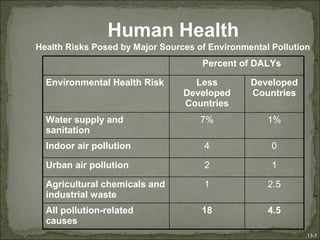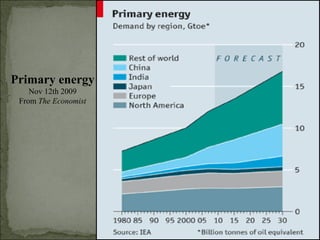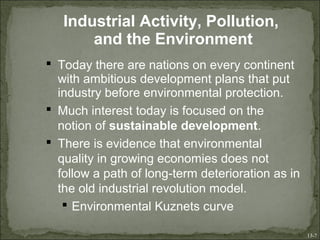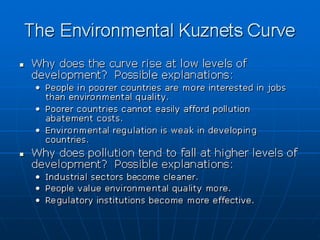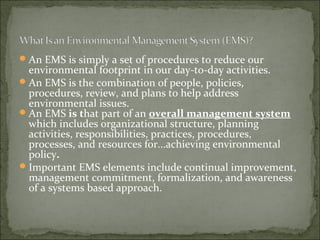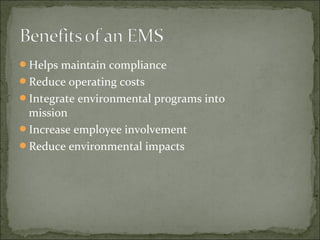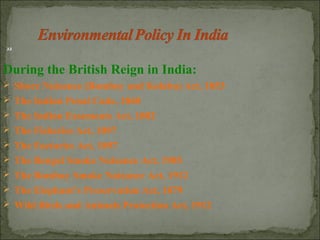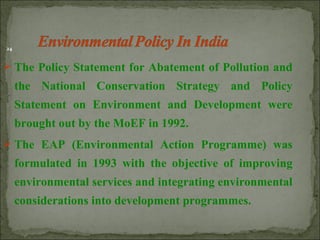Environment
- 2. Word "environment" is most commonly used describing "natural" environment and means the sum of all living and non-living things that surround an organism, or group of organisms. Environment includes both biotic and abiotic factors that have influence on observed organism. Abiotic factors such as light, temperature, water, atmospheric gases combine with biotic factors (all surrounding living species). Environment often changes after some time and therefore many organisms have ability to adapt to these changes. However tolerance range is not the same with all species and exposure to environmental conditions at the limit of an certain organism's tolerance range represents environmental stress.
- 3. Environmentalism is very important political and social movement with goal to protect nature environment by emphasizing importance of nature role in protection of the environment in combination with various actions and policies oriented to nature preservation. Some of these goals include: 1. To reduce world consumption of fossil fuels 2. To reduce and clean up all sorts of pollution (air, sea, river...) with future goal of zero pollution 3. Emphasis on clean, alternative energy sources that have low carbon emissions 4. Sustainable use of water, land, and other scarce resources 5. Preservation of existing endangered species 6. Protection of biodiversity
- 4. Ecology (from Greek: ο κοςἶ , "house"; -λογία, "study of") is the scientific study of the relation of living organism to each other and their surroundings. Ecology includes the study of plant and animal population, plant and animal communities and ecosystems. Ecologists study a range of living phenomena from the role of bacteria in nutrient recycling to the effects of tropical rain forest on the Earth's atmosphere.
- 5. life processes and adaptaions distribution and abundance of organisms the movement of materials and energy through living communities the succenal development of ecosystems, and the abundance and distribution of biodiversity in context of the environment.
- 6. Pollution Pollution refers to the release of substances into the environment that inconvenience or endanger humans. Much of it comes from natural sources. Human activity adds more contaminants. Industrial activity both harms human health and disturbs natural ecology. 13-4
- 7. Human Health Percent of DALYs Environmental Health Risk Less Developed Countries Developed Countries Water supply and sanitation 7% 1% Indoor air pollution 4 0 Urban air pollution 2 1 Agricultural chemicals and industrial waste 1 2.5 All pollution-related causes 18 4.5 Health Risks Posed by Major Sources of Environmental Pollution 13-5
- 8. Primary energy Nov 12th 2009 From The Economist
- 9. Industrial Activity, Pollution, and the Environment Today there are nations on every continent with ambitious development plans that put industry before environmental protection. Much interest today is focused on the notion of sustainable development. There is evidence that environmental quality in growing economies does not follow a path of long-term deterioration as in the old industrial revolution model. Environmental Kuznets curve 13-7
- 12. Ideas Shape Attitudes Toward the Environment Dualism Power of reason separates us from nature Progress Humans are moving to higher levels of perfection Capitalism Nature is valued as an input of production Utilitarianism Greatest food for the greatest number • Land Ethic An ethical duty to humans and nature 13-8
- 13. An EMS is simply a set of procedures to reduce our environmental footprint in our day-to-day activities. An EMS is the combination of people, policies, procedures, review, and plans to help address environmental issues. An EMS is that part of an overall management system which includes organizational structure, planning activities, responsibilities, practices, procedures, processes, and resources for...achieving environmental policy. Important EMS elements include continual improvement, management commitment, formalization, and awareness of a systems based approach.
- 14. An EMS brings together the people, policies, plans, review mechanisms, and procedures used to manage environmental issues at a facility or in an organization.
- 15. Helps maintain compliance Reduce operating costs Integrate environmental programs into mission Increase employee involvement Reduce environmental impacts
- 16. ACT CHECK DOPLAN
- 17. Plan Planning, identifying environmental aspects and establishing goals Do Implementing, includes training and operational controls Check Checking, includes monitoring and corrective action Act Reviewing, includes progress reviews and acting to make needed changes
- 18. Environmental Aspect (Cause) – The elements of an organization’s activities, products, or services which can interact with the environment. It is important to establish, implement and maintain a procedure to identify the environmental aspects of activities products and services that you “can control and …can influence.” After identifying environmental aspects you must determine those which have or can have significant impacts on the environment. Examples include: air emissions, water discharges, , use of raw materials, energy use, use of natural resources, use of volatile organic compounds. Environmental Impact (Effect) – Any change to the environment whether adverse or beneficial, wholly or partially resulting from an organizations activities, products, or services. Examples include: depletion of natural resources, air pollution, hazardous waste generation, soil and water contamination.
- 19. Facility Operations (continued) Aspect: Motor vehicle operations (Use of oil, rags, antifreeze, tires, and batteries) Impact: Hazardous waste generation and air pollution Aspect: Custodial Operations (Use of cleaning products, paper, water, energy) Impact: Depletion of natural resources and contamination of land Aspect: Grounds Maintenance Impact: Depletion of natural resources (pesticides, fertilizer, water use, fossil fuels)
- 20. Start Reduced demand Avoid use where no need Lower requirement Use lowest possible quality of energy Energy conscious behaviour Reduced distribution losses Organise energy conscious maintenance Reduce direct energy losses (insulation leaks) Reduce friction losses in distribution Avoid mixing energy flows at different pressure & temp. Increase component efficiency Increase production efficiency Reduce component looses Recovery of waste energy Use natural energy sources General principles of an energy efficiency programme
- 21. Ancient India The Arthashastra by Kautilya, written as early as between 321 and 300 BC, contained provisions meant to regulate a number of aspects related to the environment. The fifth pillar edict of Emperor Ashoka also contains such regulations 21
- 22. During the British Reign in India: Shore Nuisance (Bombay and Kolaba) Act, 1853 The Indian Penal Code, 1860 The Indian Easements Act, 1882 The Fisheries Act, 1897 The Factories Act, 1897 The Bengal Smoke Nuisance Act, 1905 The Bombay Smoke Nuisance Act, 1912 The Elephant’s Preservation Act, 1879 Wild Birds and Animals Protection Act, 1912 22
- 23. Modern India National Council for Environmental Policy and Planning was set up in 1972 which was later evolved into Ministry of Environment and Forests (MoEF) in 1985. MoEF and the pollution control boards (CPCB i.e. Central Pollution Control Board and SPCBs i.e. State Pollution Control Boards) together form the regulatory and administrative core of the sector. 23
- 24. The Policy Statement for Abatement of Pollution and the National Conservation Strategy and Policy Statement on Environment and Development were brought out by the MoEF in 1992. The EAP (Environmental Action Programme) was formulated in 1993 with the objective of improving environmental services and integrating environmental considerations into development programmes. 24
- 25. National Environment Policy, 2006 It the first initiative in strategy-formulation for environmental protection in a comprehensive manner. It undertakes a diagnosis of the causative factors of land degradation with a view to flagging the remedial measures required in this direction. It recognizes that the relevant fiscal, tariffs and sectoral policies need to take explicit account of their unintentional impacts on land degradation. 25
- 26. National Environment Policy, 2006 (contd.) The solutions offered to tackle the problem comprise adoption of both, science-based and traditional land-use practices, pilot-scale demonstrations, large scale dissemination, adoption of Multi-stakeholder partnerships, promotion of agro-forestry, organic farming, environmentally sustainable cropping patterns and adoption of efficient irrigation techniques. 26
- 27. Water (Prevention and Control of Pollution) Act, 1974 Water (Prevention and Control of Pollution) Cess Act, 1977 Air (Prevention and Control of Pollution) Act, 1981 Atomic Energy Act of 1982 Motor Vehicles Act ,1988 The Wildlife (Protection) Act, 1972 The Forest (Conservation) Act, 1980 Environment (Protection) Act, 1986 (EPA) The National Environment Appellate Authority Act, 1997 Public Liability Insurance Act (PLIA), 1991 National Environment Tribunal Act, 1995 27







